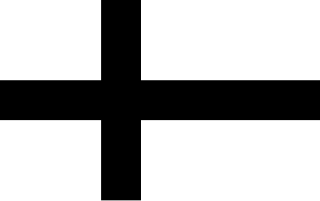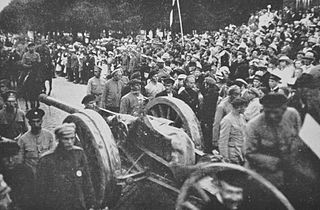
Baltic Germans are ethnic German inhabitants of the eastern shores of the Baltic Sea, in what today are Estonia and Latvia. Since their resettlement in 1945 after the end of World War II, Baltic Germans have markedly declined as a geographically determined ethnic group in the region.

The United Baltic Duchy, or alternatively the Grand Duchy of Livonia, was the name of a short-lived state during World War I that was proclaimed by leaders of the local Baltic German nobility.

The Frankfurter Rundschau (FR) is a German daily newspaper, based in Frankfurt am Main. The Rundschau's editorial stance is social liberal. It holds that "independence, social justice and fairness" underlie its journalism. In Post-war Germany Frankfurter Rundschau was for decades a leading force of German press. The newspaper was one of the first licencened by the US military administration in 1945 and had a traditional social democratic, antifascist and trade union stand.
The Deutsch-Baltische Gesellschaft is an organization which represents Baltic German refugees expelled from Estonia and Latvia during World War II and its aftermath. It was established in 1950 as the Deutsch-Baltische Landsmannschaft im Bundesgebiet.

The Latvian War of Independence, sometimes called Latvia's freedom battles or the Latvian War of Liberation, was a series of military conflicts in Latvia between 5 December 1918, after the newly proclaimed Republic of Latvia was invaded by Soviet Russia, and the signing of the Latvian-Soviet Riga Peace Treaty on 11 August 1920.

Stephan Hermlin, real name Rudolf Leder, was a German author. He wrote, among other things, stories, essays, translations, and lyric poetry and was one of the more well-known authors of former East Germany.

The Freikorps in the Baltic were German paramilitary units that formed after the German Empire's defeat in World War I. Their aim was to prevent the advance of the Soviet Red Army into the Baltic states and preserve a German presence there. The two primary units were the Eiserne Division and the Baltische Landeswehr. After initially defeating the Red Army with the help of Latvian and Estonian forces, the Allied Powers ordered the withdrawal of German soldiers from the Baltics. The German Freikorps forces then attempted to seize control of Latvia with the assistance of the local ethnic German population. They captured Riga but were driven back. Following intervention by the Allies on 3 July 1919, the Freikorps in the Baltic retreated to Germany.

The Baltic Landwehr or Baltische Landeswehr was the name of the unified armed forces of Couronian and Livonian nobility from 7 December 1918 to 3 July 1919.
Paul Schiemann was a Baltic German journalist, editor and politician who was known for his commitment to minority rights.

Estonia–Germany relations are foreign relations between Estonia and Germany. Estonia has an embassy in Berlin. Germany has an embassy in Tallinn. Both countries are full members of the European Union, NATO, OECD, OSCE, Council of Europe, Council of the Baltic Sea States, HELCOM and WTO.
The German-Baltic Reform Party was a Baltic German political party in Latvia during the inter-war period. It contested elections as part of the Committee of the German Baltic Parties alliance. The party was led by Edwin Magnus.

The Prussian mythology was a polytheistic religion of the Old Prussians, indigenous peoples of Prussia before the Prussian Crusade waged by the Teutonic Knights. It was closely related to other Baltic faiths, the Lithuanian and Latvian mythologies. Its myths and legends did not survive as Prussians became Germanized and their culture went extinct in the early 18th century. Fragmentary information on gods and rituals can be found in various medieval chronicles, but most of them are unreliable. No sources document pagan religion before the forced Christianization in the 13th century. Most of what is known about Prussian religion is obtained from dubious 16th-century sources.
Baroness Marie "Méry" von Bruiningk was a Russian Empire democrat of Baltic-German ethnicity, known for her participation in the democratic intellectual debate in the Baltic during the revolution year of 1848.
Theophil Joachim Heinrich Bienert was a Baltic German botanist who lived and worked mainly in Imperial Russia.

Thomas Wilhelm Greiffenhagen was a Baltic German journalist and politician who was the mayor of Reval from June 1883 to August 1885.

Baltisches Wappenbuch is a book detailing the coats of arms of Baltic-German noble families. The book was published in 1882 Stockholm by F. & G. Beijer. It was edited by Carl Arvid von Klingspor and illustrated by Adolf Matthias Hildebrandt.
Baltische Historische Kommission is an organization which deals with history related to Baltic Germans/Germany and Baltic states. BHK is located in Göttingen, Germany. Since 2007, BHK's chairman is Matthias Thumser.

The Neu England Rundschau was a weekly German language newspaper published by The German-American Publishing Company, Wisly Lithograph Company, and subsequently the Wisly-Brooks Company, Inc. of Holyoke, Massachusetts from 1883 until 1942, the longest running German newspaper in Massachusetts. A second edition of the paper was also sold in Connecticut under the masthead Connecticut Staats-Zeitung. Following scrutiny by the US Department of Justice and Office of Strategic Services of the broader German American press, as well as declining circulation, the paper ceased publication in 1942 during the Second World War.
Jüdische Rundschau was a Jewish periodical that was published in Germany between 1902 and 1938. It was the biggest Jewish weekly publication in Germany, and was the origin of the Zionist Federation of Germany.
Rigasche Rundschau was a daily German language newspaper published in Riga from 1867 until 1939. Widely read and quoted across Europe, it was considered the most important Baltic German newspaper as well as the leading liberal periodical in the Russian Empire and independent Latvia during the interbellum. The newspaper experienced its zenith of influence and popularity under Paul Schiemann, who served as chief editor until his removal by supporters of National Socialism in 1933.











